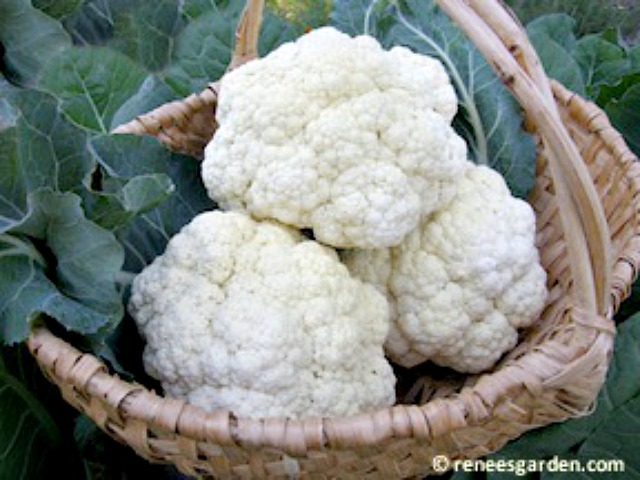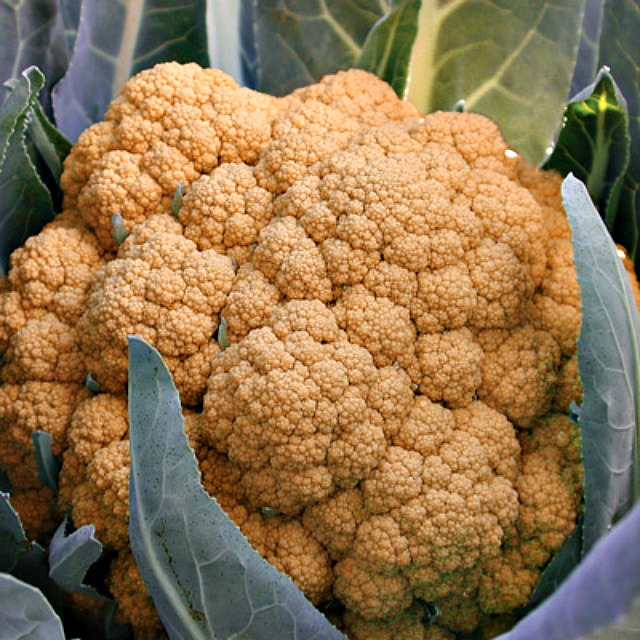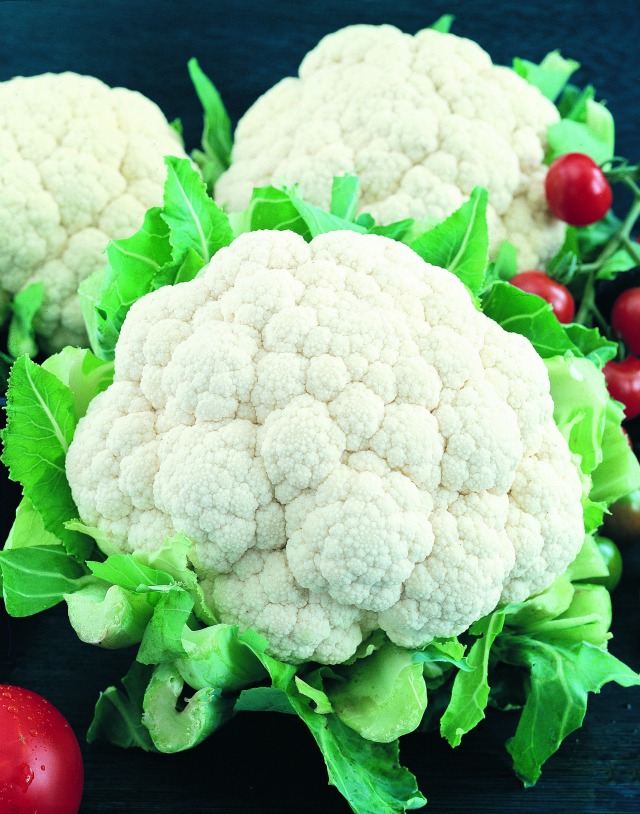
Kale, the hottest health trend in veggies for some time now, has been usurped by what the media is calling the new ‘it’ vegetable. And you know what that vegetable is? Cauliflower! Yep, it’s true. What was once a boring, even denigrated vegetable, has become extraordinarily popular within the last year.
If you think cauliflower is limited to the white variety, think again. At supermarkets, like Whole Foods, there are purple, yellow, green and even some wild looking ones like romanesco: professional chefs are having a field day and using them in exciting ways.

Christine Keller, who maps food trends at the CCD Innovation culinary product development agency says: “Cauliflower can do all sorts of culinary tricks…..unlike kale, which doesn’t taste as great to everyone, but became popular through juicing or chopped in raw salads. Cauliflower is moving to the center of the plate.”
Just a few weeks ago, an article in The Washington Post, titled “Cauliflower is so hot right now you may not be able to afford it — or find it” Why? High demand, unseasonably cool temperatures in farming regions and a limited supply are resulting in absurd prices for the latest ‘it’ veggie.
Believe it or not, cauliflower is fetching $7.99 for an organic head at the Takoma Park Silver Spring Food Co-op and Philadelphia’s Weavers Way Food Co-op actually stopped stocking the vegetable for 3 weeks because they thought the high price would be a turn-off to their buyers.
I found an article and video that recently ran in the New York Times (along with some terrific music) very useful and entertaining. It’s title: How To Roast Cauliflower (The Whole Thing).
It seems that the latest re-incarnation of cauliflower originated with an Israeli chef, Eyal Shani, who served it in his restaurant.
Below is Shani’s thoughts about and recipe for the whole roasted cauliflower:
“The dish appears simple, but the secret to its success is in the precision of technique”, says Shani.
“The recipe is ultimately very simple – you cook a good small- to medium-sized cauliflower; the smaller they are, the sweeter. Nowadays [at Shani’s restaurants] we work with a special variety of cauliflower that’s grown just for us, over entire hills in the Negev. You cook the cauliflower in salted water and then let it drain like cooked potatoes. You let all the steam dissipate, and then you cover it in olive oil and stick it in the oven,” he said.
The trick is in applying the oil to the cauliflower, he says. “We’d stick our hands in olive oil, remove the excess and then rub the cauliflower. Any other way and it doesn’t work,” he says.
Shani, known for waxing poetic when he talks about food, has a full philosophy underlying this roasted cauliflower as well.
Generally, cauliflowers are cut into pieces when cooked, he notes.
“All our lives we’ve been ripping apart a flower, and I realized I’m not willing to break [that flower] anymore,” he says.
The dish’s large size invites sharing, in a vegetarian version of traditional communal meals based on meat.
“People don’t tend to be generous with their vegetables. With meat they are, and this is something primordial within us. The cauliflower engenders generosity,” he says.
The cauliflower’s form appeals to our instincts in other ways, too, he says.
“There’s something in people that very much likes taking apart the precise forms of nature. It’s the same with the cauliflower. When you break it apart with your hands, you experience a joy that doesn’t exist when you’re eating a meal with a knife and fork,” he says. “The cauliflower brings us back to the most primordial savagery but no animal has died for this.”
Renowned chefs around the world all have their own variations of Shani’s signature whole roasted cauliflower. Here’s the version popularized by the chef himself, as published in Haaretz 10 years ago.”
Recipe by Eyal Shani and Miri Hanoch.
Serves 4
Ingredients:
1 whole medium-size, fresh, white cauliflower, florets tightly packed and covered in bright green leaves
3 tbsp. olive oil
mineral water
sea salt
Preheat the oven to 430 degrees Fahrenheit (220 degrees Celsius). Place the cauliflower in a metal pot and fill until 3/4 full with mineral water. Add about 10 grams of salt per liter of water. Cover with a lid, bring to a boil, lower to a moderate boil and cook for 10-15 minutes, depending on the size of the cauliflower. Drain.
Brush the cauliflower with olive oil and sprinkle with a little salt. Place in a baking dish, place the dish in the center of the oven, and bake until the top turns golden brown.
Serve to the table in the baking dish. The outside of the cauliflower should be crisp and the inside as soft as butter. Separate the florets with a spoon and serve.”
Source: Haaretz
Where To Buy Cauliflower Seeds
Most of the sources listed below offer several varieties.
Renee’s Garden
Cauliflower “Amazing Taste” is an outstanding early Dutch hybrid that produces dense heads of tender, creamy white curds with superb mild, nutty sweet flavor. Strong outer wrapper leaves protect both head quality and color.

Photo Source: Renee’s Garden
Territorial Seeds
Orange Burst Cauliflower is not only stunning but is delicious and extra-nutritious. Its orangish coloration is due to its high beta-carotene content. Toss into a salad or cut the curds into bite-sized pieces on a raw veggie plate for a presentation that will spark envy in your dinner guests. The orange color, which is retained when cooked, looks as good as it tastes in au gratin or simply steamed. Maturity is 80-90 days

Photo Source: Territorial Seeds
Burpees
‘Healthy Mix‘ is “loaded with 25% more vitamin A than all other white varieties, a sweet nutritious, colorful mix for salads. Color shifts to green when cooked.”

Photo Source: Burpee Seeds
Sustainable Seeds
They write: “Heirloom organic cauliflower is a cool season vegetable that may be considered a challenge to those who haven’t learned its secrets. It is a crop that needs both correct soil and climatic requirements. However, it can be grown successfully if it is planted so that it will mature in the early summer or in the fall.”
My top pick from their selection is: Organic Self Blanching Cauliflower
It takes 68 days to mature and has self-wrapping leaves that shield the snow-white curds from the sun. They remind you that because cauliflower is a cool weather crop that you should put seedlings that have been grown indoors for an early spring crop or wait and plant seedling in the fall for best crops.

Photo Source: Sustainable Seeds
How to Grow Cauliflower From Seed
You can have success growing cauliflower in your veggie garden or container, if you recognize that cauliflower is a cool season crop that needs consistently cool temperatures in the 60s.
Here is advice from the Farmer’s Almanac:
- Select a site with at least 6 hours of full sun.
- Soil needs be very rich in organic matter; add composted mature to the soil before planting. Fertile soil holds in moiture to prevent heads from “buttoning.”
- Test your soil! (Get a soil test through your cooperative extension office.) The soil pH should be between 6.5 and 6.8.
- It is best to start cauliflower from transplants rather than seeds. Transplant 2 to 4 weeks before the average frost date in the spring, no sooner and not much later.
- Space the transplants 18 to 24 inches apart with 30 inches between rows. Use starter fertilizer when transplanting.
- Plant fall cauliflower about the same time as fall cabbage. This is usually 6 to 8 weeks before the first fall frost and also needs to be after the temperature is below 75 degrees F.
- If you really want to try starting cauliflower from seeds, start the seeds 4 to 5 weeks before the plants are needed. Plant the seeds in rows 3 to 6 inches apart and ¼ to ½ of an inch deep. Do not forget to water the seeds during their germination and growth. Once they become seedlings, transplant them to their permanent place in the garden.
- In early spring, be ready to cover your plants with old milk jugs or protection if needed. For fall crops, shade them if they need protection from the heat.
- Add mulch to conserve moisture.
CARE
- Make sure that the plants have uninterrupted growth. Any interruption can cause the plants to develop a head prematurely or ruin the edible part completely.
- Cauliflower requires consistent soil moisture. They need 1 to 1.5 inches of water each week; with normal rainfall, this usually requires supplement watering.
- For best growth, side-dress the plants with a nitrogen fertilizer.
- Note that the cauliflower will start out as a loose head and it takes time for the head to form. Many varieties take at least 75 to 85 days from transplant. Be patient.
- When the curd (the white head) is about 2 to 3 inches in diameter, tie the outer leaves together over the head with a rubber band, tape, or twine. This is called blanching, and it protects the head from the sun and helps you get that pretty white color.
- The plants are usually ready for harvest 7 to 12 days after blanching.
Please note: if you live in a colder climate, you can start seeds now for a spring crop. Otherwise, germinate seeds indoors this summer for a fall crop.
NOW IT’S YOUR TURN. If you have any cauliflower recipes you want to share with us or stories on how you’ve grown cauliflower successfully in your garden, I would love to hear from you.
Also, if you enjoyed this article, please share with others. It’s good karma! Love Fran
